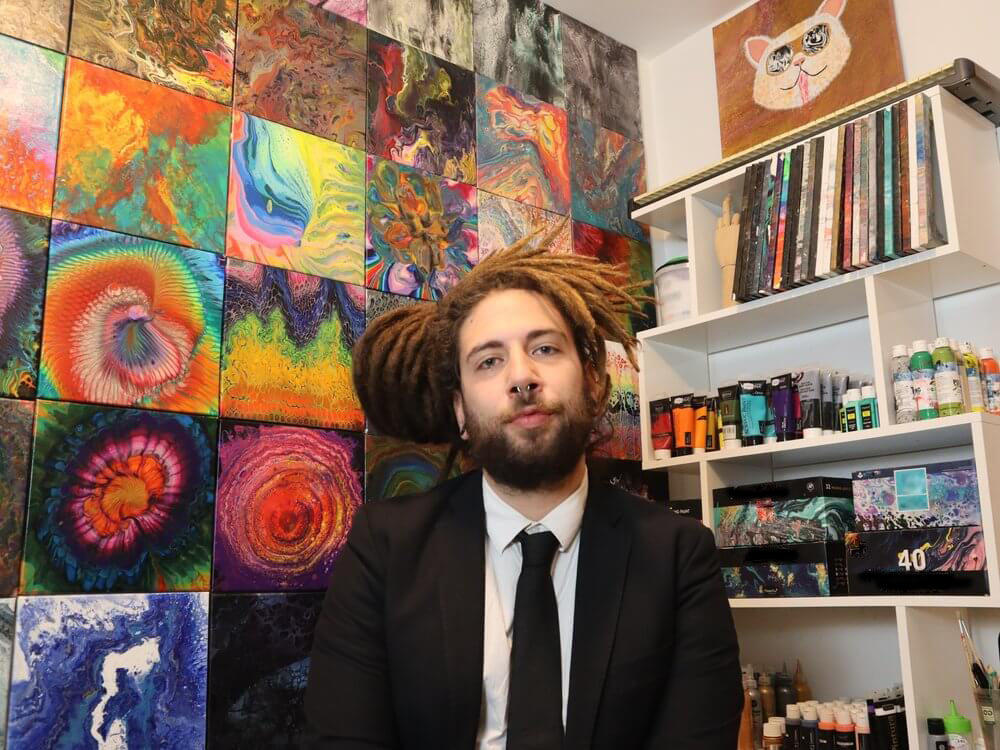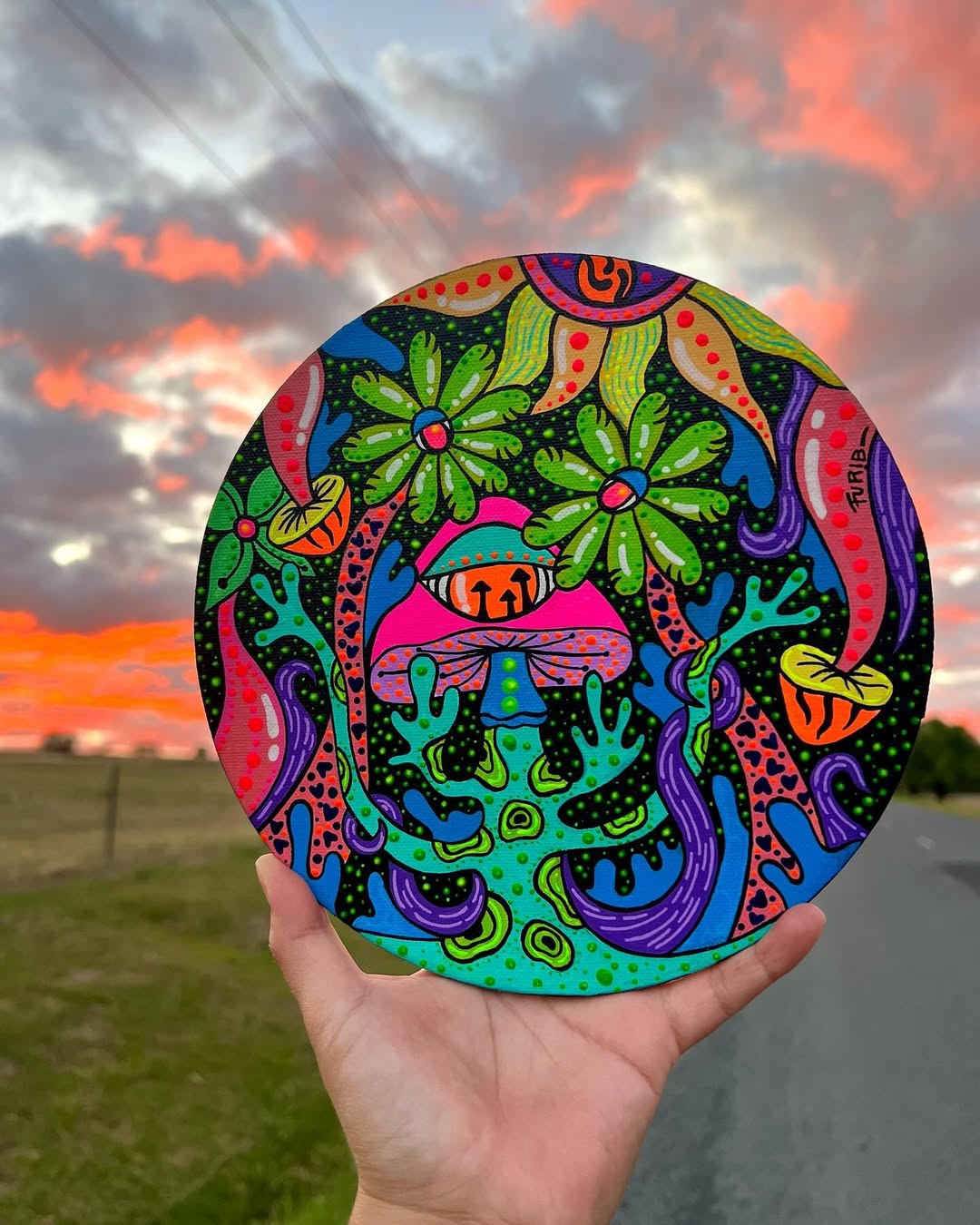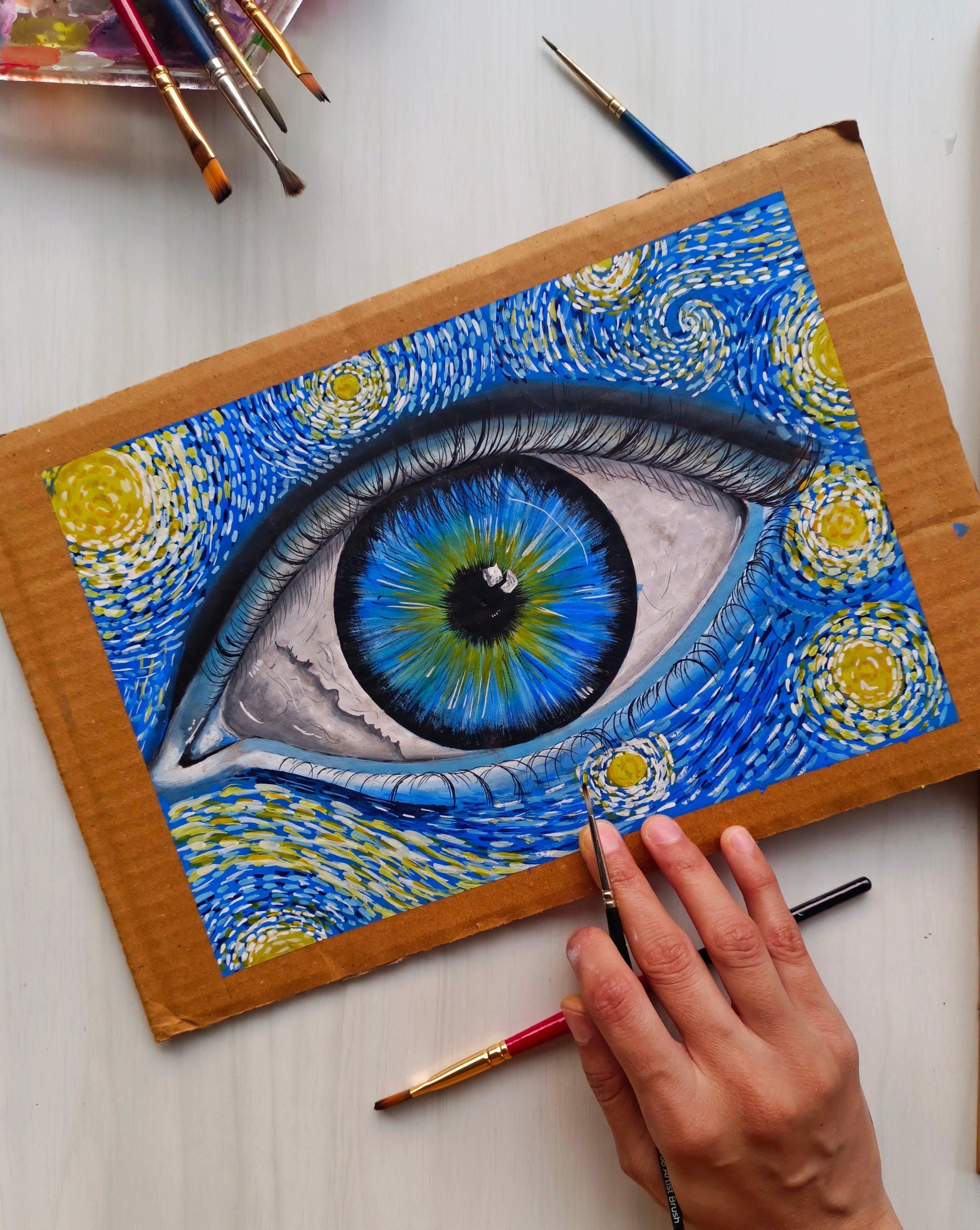A life in music was the creative outlet for Mr Goodriddance (@mrgoodriddance). But with a passion waning, he unplugged the guitar and picked up some acrylic paint, challenging himself to paint every day for a month. Two years on and he’s still painting.
Fast forward to today, the Barcelona-based, pouring artist creates abstract pour paintings, upcycles furniture and turns the leftovers into jewellery, making sure no art is left behind.
We unravelled Mr Goodriddance’s creative journey from retired rockstar to painter and how he tackles the challenge of recycling and reusing in art.

How did your journey to becoming an artist unfold?
I’ve always felt a sense of urgency to make art. I think that for a lot of people, art is a way of losing themselves in the moment, but for me it’s always been a way of finding myself, too. I love disconnecting from the world around me and creating something unique, out of my heart and brain. But in that disconnection, I find my time to meditate, think about life, where I am and where I want to go. I feel that having a creative outlet has always been the foundation to a happy life for me, so much so, that experiencing periods of creative block in the last 15+ years has always led me to times of internal struggle.
After I gradually lost my passion for music, I searched for a new way of expressing myself for years, until I eventually decided to pick up some acrylic paint and make a painting a day for a month to build a new habit. From then, I never stopped creating, and that brings us to today :)
How do you approach a new artwork? Is it a planned process or completely intuitive?
I look at my art as a halfway point between artistic instinct and careful planning. I like to create music videos that illustrate my painting process, so I usually start from selecting a song to use for the edit, and then I spend sometimes a silly amount of time imagining how to cut my footage to adapt it to the beat of the song, how to create transitions that will sync with elements of the music, and how to place my paint on the canvas to make sure my editing process is as quick and smooth as possible. Often, I’ll pick a palette that fits the mood of the song, but other times I’ll simply explore a technique in different colours and variations.

You don’t just paint canvases, you also upcycle your art, transforming unwanted furniture to art. How did this idea come about?
I’m fascinated by the idea of functional art, and I also think we live in an extremely wasteful society where the interest in repairing objects -- and giving them a new life, has been declining due to the ease of access to new, cheap items. I’m guilty of this too. But when I was furnishing my apartment, I saw an opportunity to create unique pieces that would add character, in furniture that nobody wanted because of aesthetics. I’m now planning on upcycling an old metal table I recently found left near the trash in the street, it’s in bad shape but it makes for an exciting project!
How is the process of upcycling art different to approaching a blank canvas?
It’s really the same, because I look at the surface the same way I do with a canvas, but it’s completely different all at once.
For starters, I need to rearrange my light and camera set ups and get a bit creative to adapt to the space I have in my flat. Then, I have to visualise how the piece will fit in the environment where it’ll be placed and choose a colour palette and technique that can complement the surroundings. Finally, because I use epoxy resin to seal the pour, a lot more work goes into a piece than a normal painting, from carefully cleaning the surface, to mixing the resin, spreading it, curing it while drying, sanding the edges after dried, etc.
These projects are time consuming, pricey, and take up quite a lot of my studio space, but both the process and the results are always incredibly satisfactory for me. Sometimes upcycling becomes a reactive need rather than an active interest: fluid art has the downside of being potentially wasteful -- some techniques lead to paint flowing off the canvas. I usually leave this paint to dry and use it to create colourful cabochons to glue to earrings and ring bases. This is another way to ensure waste is limited to the bare minimum, paint is upcycled, and no piece of art is “left behind”.

You used to be a musician; how important is music in your art?
It’s vital, and I believe that painting has been key in finding my passion for music again, so it goes both ways. As I mentioned, any time I edit a video for social media I will sync it to a song, and I like to explore as many genres as possible because it’s a reflection of my listening habits. However, this can be as inspiring as it can be limiting, I often had to remove parts of the process I would have liked to include, simply because they didn’t fit within the time format required for Instagram reels, or there was no dynamic in the music that would organically match the movements on camera. Plus, people react viscerally to the music they like, so this adds an extra layer for them to be engaged with my art, and an extra way for me to communicate my mood.
How did it feel when you started to show people your work for the first time?
It felt great, because for the first time, I had a plan before sharing my art: before opening my Instagram account and website, I spent many months coming up with my branding, logo, intro/outro videos, timeline with milestones to reach, and I fully dedicated myself to experimenting, creating a large catalogue to share, and establishing an artistic identity. Guests in my home were the first “passive audience” I had since they were noticing the art on the walls of my house and asking me about it. They were the first to push me to start sharing my hobby with a larger audience, and the first sales gave me extra motivation to invest in high quality recording and studio equipment. I’m also extremely lucky: the fluid art community is an exceptionally positive, caring, and supportive group of artists, so I felt immediately overwhelmed by amazing feedback and interest in my journey.

What three art products would you take to the moon?
I’ll assume we’re speaking figuratively, because the low gravity on the moon would seriously compromise the effectiveness of all my picks. ;P We obviously need to start from silicone oil by Mont Marte ;) possibly the most frequent question I get asked is “what do I add to my paint to create my cells,” and the answer I give is always the same: Mont Marte sells magic in tiny bottles and calls it ‘silicone oil.’
The second item would probably have to be my spinner: one of the cheapest tools I bought for my art (it’s a plastic cake spinner, you don’t need anything fancy!), and most definitely the best investment. I spent my first months working with acrylic pouring techniques where I would tilt the canvas and I was often disappointed by the loss of form in my compositions, the spinner allows me to maintain and enhance them. 11/10 would recommend!
Finally, 3M command strips. I wanted to create a wall completely covered in artworks in my studio, and drilling holes for 80 paintings would have been…impractical. These strips allow you to hang your artwork without damaging the walls and remove it or replace it anytime you want. I add a few of these to any painting that I sell so buyers can hang it without ruining their walls!
When do you find that you’re most creative?
I always feel creative! Sometimes, I just don’t feel inspired :P. But I admit I have a soft spot for painting all-nighters -- where at the end of my session I can leave the paintings to dry, while I enjoy watching the sun rising from my terrace. I’ve always been a night owl, I guess late hours are the best for me because so many distractions are removed and I’m less likely to receive a phone call while my hands are covered in paint!

How does social media influence what you create?
I am a fan of social media when it comes to allowing creators to reach viewers --they would have never been able to interact with 20 years ago, but for the most part, I try to stay away from it as much as possible. At least for me, it’s always been a distraction more than an inspiration, which is the reason I decided not to have personal accounts but simply use it as a tool to share and promote what I create. In the end, social media influences what I do, to the degree I allow it to do so. Sometimes I know I need to play the game to try and maximise reach and engagement, so I’ll pick a song at the top of the charts for one of my videos, for example. At the same time, I also feel like it’s detrimental to my productivity -- if I didn’t have to set up recording equipment to make sure I capture everything I paint, I would paint much, much more.
Creatively, what’s something you had to unlearn?
To rely on someone else. I was never a solo musician, I always played in bands with my friends, who were often more talented and more creative than me. I believe that surrounding yourself with people from whom you can constantly learn from, is something that's still extremely important in life, but in music it became a constraint, because I never felt I had enough talent by myself. So, I knew that this time around I had to find a way to do everything by myself without being afraid of failing.
Sometimes I think about how funny it is that, to become a painter, I had to also become a videographer, editor, website designer, social media manager, marketer, and so many other “jobs” that I do by myself. The idea of having to learn all these skills is so overwhelming, but it’s happening in such an organic way, that I almost haven’t noticed spending so much time researching and improving.

Who would you switch lives with for a day?
Sir David Attenborough. I’d love to go through his memories to see how colourful the world used to be and get some inspiration from it. I’d also use his voice to record narrations for all my painting and project videos before I switch back to my regular life :D
What would you do if you had infinite time and money?
I’d buy a warehouse in Bali filled with hundreds of litres of paint and huge canvases, get some tailored Armani suits, a pension for my mum, and hire a video editor, because I want to go back to having time during the day to go live life lol. Regarding infinite time though, if it means living forever - ugh, I’d probably dedicate a lot of money towards researching how to make time finite again, because nobody really wants to live forever!!
We hope that you feel inspired by Mr Goodriddance and his art. We’d love to see what you create too! #montmarteart or tag us @montmarteart on Instagram or Facebook. Or if you’re looking for more creative inspo, check out more of our featured artists.





























